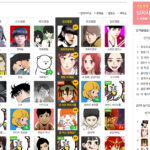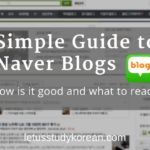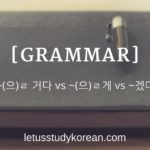(Estimated reading time: 6 minutes)
Every month, I will highlight some interesting and sometimes new discoveries I made over the course of the month while studying Korean.
As we approach the end of March 2017, I’m here to give some updates on what I’ve been studying! If you haven’t checked out previous months’, please do give them a read!
Online Resources
1. Videos with Korean subtitles (Low-intermediate and up)

I’m not sure about you but as a Korean learner, I’m really hungry for Korean subtitles when watching any sort of videos. You should know how quickly Koreans speak and because we’re not familiar with the language, we often mishear some of what are said. Thank god for these content creators who post videos with subtitles (hard or soft)!
There are many more of similar content creators and I’ll be sure to update the list (can be found on the Studying Resources page here). Meanwhile, I’ve watched quite a number of these videos during my free time in the recent days after discovering these pages (mostly on Facebook). I would say these are more entertaining than really educational for me but to each his own!
2. Translating news articles (Low-intermediate and up)

I’ve been doing this for a long time ever since I gained some proficiency in Korean (always with the help of Daum and Naver dictionary, though…) but I only focused on celebrity gossip, particularly about the K-Pop girl group T-ara. I personally think translating is a good way of discovering new vocabulary simply because you are forced to use the dictionary when you see any words you don’t know! For me, Daum and Naver dictionaries have been a crucial part of my Korean learning journey. Looking up the dictionary is tough work but not when you have technology on your side!
Another thing about translating news articles is you’ll learn how to better identify grammar particles and their uses, which will ultimately help in expression (very important!). If you don’t understand long sentences, break them up into individual clauses, translating those then proceed to join them up.
If you have a teacher or tutor, seek their help to proofread and check if your translation and understanding are on the right track. It’s going to be really hard at first but you’ll get better article by article.
3. italki (All levels)

I’m going to mention italki (again!) in this post and probably even the next because of how much italki has helped me with conversational Korean. I’ve written a number of posts by now so if you’re curious how this has worked for me, read them here.
First things first, I’ve been sticking to one italki tutor because she’s quite a good conversationalist – the most important deciding factor for me, at least. Sure, her knowledge in Korean is important but I think what makes a great 1-on-1 tutor or teacher is his or her conversation skills. You can have a PhD in Korean as a teacher but if he or she doesn’t know how to hold a proper conversation, the lessons will be as boring as twiddling my thumbs all day.
I guess it’s also because we’re about the same age that most of what we talk about are relatable to both of us. Anyway, I would be writing a blog post about how to know if you need a Korean teacher or tutor and what to look for in one. Part of the inspiration for this upcoming blog post is from reading Peak by Anders Ericsson and Robert Pool. It’s a book on how to achieve expert performance in almost any skill or expertise and I highly recommend it.
4. Journaling (All Levels)
I’ve been journaling every weekday on Google Docs and my italki tutor has been proofreading and editing them for me! I’ll post up some of the journal entries with interesting corrections and explanations. Hopefully, those will help all of you understand how to better form sentences too. Some of the short phrases I shared in the weekly phrases posts are actually from my italki lessons. After I’ve sought the permission of my italki tutor, I’ll post those journal entries here, keeping my fingers crossed!
But more on journaling itself, it’s actually a great way to practice and I believe the founder of TTMIK, Hyunwoo, actually made a video saying how journaling is probably one of the most effective ways to practice Korean. I should put it out there, though, that journaling was actually a suggestion made by my tutor. She’s helping me aside from the italki lessons in return to help her with Chinese and English.
Journaling helps you process your thoughts in Korean (hopefully) or at least give you a chance to translate your thoughts into Korean before penning them down. I don’t know many who do this on a regular basis but I’m definitely seeing the benefits of journaling after more than a month. I’m noticing lesser grammar mistakes, better expressions and a wider range of vocabulary. Of course, this is only possible if either you’re at a proficiency where you can self-check or a native/proficient speaker is able to give you valuable feedback.
Closing thoughts
I’ve been spending much of my time journaling in Korean on top of the usual italki and Daehan lessons. I wouldn’t be able to rank which one contributed the most to this month’s improvements because they all work only when done together. The same applies to you – don’t focus on just one way or method of studying Korean, you’ll hit a wall. Study regularly but add some variations into what you work on – reading today, listening tomorrow and writing the day after, or whatever works best for you. It’s best that we work on all areas every day but it’s hard to set such a schedule, take baby steps!
Anyway, from this blog post, it seems like there is room for further discussion on translating news articles, how do we know if we need a Korean teacher or tutor and how to find a suitable one, and last but not least, journaling!
I’ll be writing on these topics in April and definitely other creative and fun ways to study Korean.
Be sure to stay tuned for next month’s update! Until then, Let’s Study Korean 한국어 공부하자!
Important links
Related LSK blog posts
1. On videos with Korean subtitles
2. Studying Resources page
3. On self-study VS taking classes
4. Articles on italki
5. Weekly phrases
Studying Resources
1. Videos with Korean subtitles (Low-intermediate and up)
2. Translating news articles (Naver & Daum) (Low-intermediate and up)
3. italki (All levels)
4. Journal writing on Google Docs (All levels)
Other mentioned links
1. Daum and Naver dictionaries
2. Peak by Anders Ericsson and Robert Pool
3. TTMIK video
*Note: This is the first time I’m using an Amazon Affiliates link. If you buy the book using the link above, I’ll get a really modest commission at no extra cost for you. You’ll be supporting the site!





